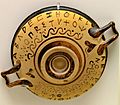Gamma facts for kids
 |
|||
Quick facts for kids Greek alphabet |
|||
|---|---|---|---|
| Αα | Alpha | Νν | Nu |
| Ββ | Beta | Ξξ | Xi |
| Γγ | Gamma | Οο | Omicron |
| Δδ | Delta | Ππ | Pi |
| Εε | Epsilon | Ρρ | Rho |
| Ζζ | Zeta | Σσ | Sigma |
| Ηη | Eta | Ττ | Tau |
| Θθ | Theta | Υυ | Upsilon |
| Ιι | Iota | Φφ | Phi |
| Κκ | Kappa | Χχ | Chi |
| Λλ | Lambda | Ψψ | Psi |
| Μμ | Mu | Ωω | Omega |
| Other letters | |||
| Ϝϝ | Digamma | Ϟϟ | Koppa |
| Ϛϛ | Stigma | Ϡϡ | Sampi |
| Ͱͱ | Heta | Ϸϸ | Sho |
| Ϻϻ | San | ||
Gamma (written as Γ for uppercase and γ for lowercase) is the third letter in the Greek alphabet. It makes a "g" sound, just like the "g" in "go." People in Ancient Greece used it, and it's still used in Modern Greek today.
In the Greek number system, Gamma has a value of 3. Many letters in other alphabets came from Gamma. For example, the Roman letter C and the Cyrillic letter Г both have their roots in Gamma.
Contents
What is Gamma?
Gamma is a very old letter with a long history. It's part of one of the world's oldest alphabets, the Greek alphabet. This alphabet was very important because it influenced many other writing systems we use today. The shape of Gamma has changed a little over thousands of years, but its meaning and sound have stayed mostly the same.
Gamma in Math and Science
Gamma isn't just a letter; it's also used as a symbol in many areas of science and mathematics.
Gamma in Mathematics
In math, the lowercase γ (gamma) often stands for a special number called the Euler–Mascheroni constant. This constant appears in many complex math problems. The uppercase Γ (Gamma) is used for something called the gamma function. This function is a bit like a factorial (like 5! = 5x4x3x2x1) but for all numbers, not just whole numbers. It's also used in gamma distribution, which helps scientists understand how certain events are spread out.
Gamma in Physics
In physics, especially when studying waves and heat, the lowercase γ (gamma) is used. It represents the ratio of specific heat. This helps scientists understand how much energy it takes to raise the temperature of different substances.
Related pages
Images for kids
See also
 In Spanish: Γ para niños
In Spanish: Γ para niños


